Recreating a city
Though it would be dubbed “The Wizarding World of Harry Potter – Diagon Alley”, the new land at Universal Studios Florida would incorporate other areas besides the magical shopping street.
Facing out onto Universal Studios Florida’s lagoon would be the London Waterfront, incorporating a host of recognizable locations from real-world London. The area would play two key roles. Firstly, it would establish the setting for the new Wizarding World, and provide an external façade to face on to the rest of Universal Studios Florida. Secondly, it would completely conceal Diagon Alley and its contents, and ensure that the rest of the park wasn’t visible to guests inside the Wizarding World. “Once you’re inside Diagon Alley”, promised Gilmore, “there’s nothing else. You are in Harry’s World.”
In the books and movies, “muggles” are not aware of the existence of Diagon Alley. Entrance can be gained by tapping a specific brick in order to unveil a hidden alleyway. “That goes completely against what you would do in a theme park,” says Coup. “When you know that millions of guests are going to be going into Diagon Alley, you want to put big signs up. But we didn’t want to do that because it’s not that way in the stories.” Instead, the entrance to Universal’s recreation of Diagon Alley would be hidden by slanted brick walls which would appear solid from the front view, with an accompanying “sliding” sound effect giving the impression that the bricks were moving as guests passed through. On reaching the other side, they would see the transforming wall frozen in time as a sculpture.
In Hogsmeade at Islands of Adventure, guests are drawn up the main shopping street towards the iconic Hogwarts Castle. In Diagon Alley, the role of the castle would be taken by Gringotts Wizarding Bank, the goblin-operated financial institution in which witches and wizards store their money and other valuables in heavily-guarded vaults. Sitting atop the multi-story structure would be an enormous, 60-foot dragon – one that would actually breathe fire. “We say that about the dragon, and people think we’re goofing around,” comments Woodbury. “We’re not. This one blows a giant ball of fire.”
The first Wizarding World had been a huge success, but it had also taught Universal some painful lessons. Many of these related to its cramped layout, which made managing crowds very difficult. The undersized merchandise outlets were also a major bottleneck, with long lines of guests waiting to enter Ollivanders in particular.
The challenge in Diagon Alley was to make things larger and roomier, while still ensuring that the area and the buildings within it closely resembled what was seen in the movies. Dale Mason, Director of Creative Development, explains: “When we laid out Hogsmeade and began that process we never realized [the size of] the crowds. [In Diagon Alley] we needed to be true to the story which was to keep things tight and close, but we also needed to have the space. And I think we’ve achieved pretty well this feeling of a very tight, close urban environment but still having space for our guests.”
The Diagon Alley version of Ollivanders would offer an identical show to the Hogsmeade store, and would have an exterior that was faithful to its appearance in the movies. Inside, however, there would be major improvements. There would be three showrooms, rather than one, enabling guests to pass through much more quickly. The store itself would also be enlarged, ensuring that eager buyers could grab their own wands more easily.
There were positive lessons from Hogsmeade to be applied to the new project, too. “[With Hogsmeade] we learned that people enjoy the environmental experience as much as they enjoy the ride experience,” says Woodbury. “That’s why this environment is so much more elaborate and expansive.”
Diagon Alley itself would be lined with shops and dining outlets, with the first stop being the Leaky Cauldron pub – the area’s main restaurant. A selection of shops seen in the books and movies would be open to guests, including the Weasley’s Wizard Wheezes joke shop, Madam Malkin’s Robes for All Occasions (selling character costumes and Hogwarts school uniforms) and a second version of Ollivanders Wand Shop.
Gilmore explained that the second Wizarding World would be “a maze crisscrossing itself.” Running off Diagon Alley would be Knockturn Alley, frequented in the stories by practitioners of the “dark arts”. This would be headlined by Borgin and Burkes, selling items such as Death Eater masks, skulls and replica costumes. Unlike Diagon Alley, Knockturn Alley would feature a ceiling, ensuring that it would remain dark and gloomy even during Florida’s bright, sunny summer days.
Despite the inclusion of both Diagon Alley and Knockturn Alley, Universal was keen to increase the scale and scope of the new land. This meant adding two new areas that were not featured in the books and movies, and were designed in conjunction with J.K. Rowling. The first, Horizont Alley, would provide additional space for stores. The second new area would be Carkitt Market, named by Rowling herself and inspired by London’s covered Leadenhall Market. This would host live shows, and would also be home to the Gringotts Money Exchange, where guests could swap “muggle money” for wizarding bank notes.
The real deal
In order to ensure that fans (and Rowling) would be satisfied that Universal had succeeded in recreating the “true” Diagon Alley, Universal again relied on significant players from the movies’ production teams. “Having a guy like Stuart Craig involved was pretty critical,” says Woodbury of the Production Designer. “Bringing the entire crew of the Harry Potter film franchise back together in a way to help us make this as real and authentic as possible was really important and a very active part of the process.”
Coup felt that the opportunity to build a real-world version of Diagon Alley was too much for the likes of Craig and Gilmore to resist. “We clearly get the feeling that this was a dream come true for them, because when they get to design sets when they work on films they are limited to what the cameras can see. Often there are no ceilings. When you walk into the Diagon Alley movie set you can see the ceiling and all of the lights. One of the comments from the cast when they walked in [to Universal’s Diagon Alley] was ‘Wow, there’s the sky!’”
To ensure that the streets could accommodate large numbers of guests, but would still feel suitably hemmed in on both sides, the buildings would be constructed on a large scale. “We realized every detail of Diagon Alley, so we have finished all the buildings, all the way to the top,” says Gilmore. “The streets lean in on top of you, it’s all twisty and old England.”
Despite their flimsy, aged appearance, the buildings themselves would be built around a sturdy steel framework. This was designed to ensure that the structures would be able to withstand the frequent hurricanes endured by Central Florida’s theme parks, complying with modern building codes.
“I think Diagon Alley is utterly unusual,” says Gilmore. “Coming from a film team where we only ever built Diagon Alley maybe 20 feet high, we’ve had a chance to build it for real. Everything is there – roofs, chimneys, inside the rooms. It’s a real, breathing city. The scale is so magnificent. To tell all these stories and layers of stories is a real joy.”
Multiple time periods would be evoked in the design of the buildings and the streets themselves. “The place has been very authentically designed to represent a palate of British architecture in London,” claims Gilmore. “The Leaky Cauldron is a medieval building, which is, say, 1,000 years old. You have the Victorian streets and Victorian architecture of London. Stuart [Craig] drove a design logic where it’s almost an enhanced reality, where the buildings lean a little bit more, and the columns are a little bit stronger, to give that sense of magic.”
"I want people to walk in here and experience every level of detail. I want them to look at the buildings and realize these are real buildings. This is really old, magical London. I want them to think, ‘My gosh, I've been transported to another time.’"
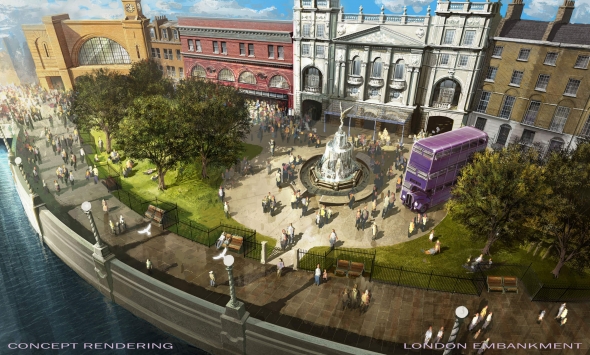
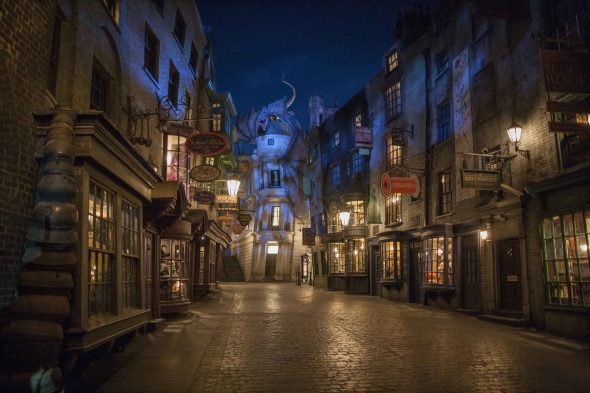
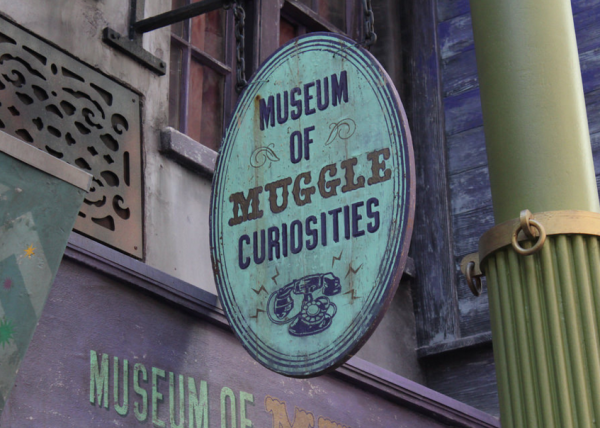
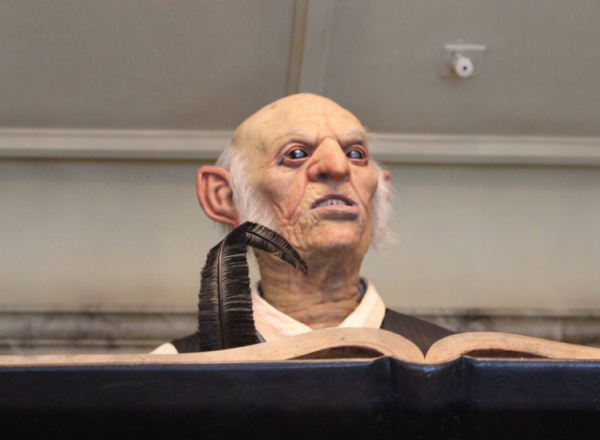
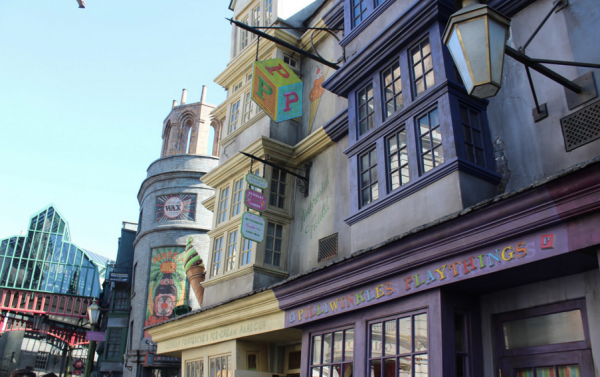

Comments
This is an amazing article. I live in Orlando, and have been to US and IOA since they opened. I learned things I didn't know! Thanks for all the insider info!